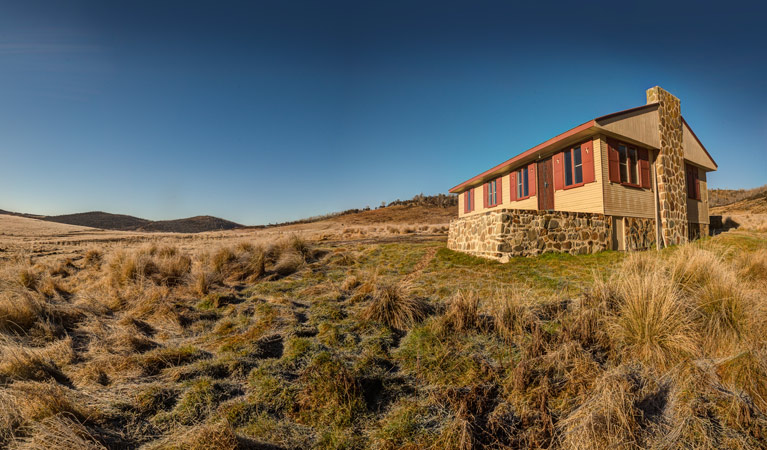Wolgal Hut
Selwyn area in Kosciuszko National Park
Overview
Wolgal Hut is closed because of severe damage from bushfires.
| Accommodation type | Lodge |
|---|---|
| Bedrooms | 3 |
Wolgal Hut, in the subalpine district of Kiandra, is closed due to severe bushfire damage. Rich in history, the area around the hut was home to one of Australia’s shortest gold rushes and is considered the birthplace of skiing in Australia.
Before it closed, this historic hut made a great base for exploring the high country of the Australian Alps in Kosciuszko National Park.
Local alerts
For the latest updates on fires, closures and other alerts in this area, see https://www.nationalparks.nsw.gov.au/camping-and-accommodation/accommodation/wolgal-hut/local-alerts
Operated by
- Tumut Region Visitor Centre
- 9am to 5pm daily. Closed Christmas Day.
- 02 6947 7025
- tumutrvc@environment.nsw.gov.au
- The Old Butter Factory, 5 Adelong Road, Tumut NSW 2720
Park info
- in the Selwyn area of Kosciuszko National Park in the Snowy Mountains region
The Selwyn area is open all year, but some roads and trails may close due to weather conditions or park management issues. Kings Cross Road and the Khancoban-Cabramurra Road are closed in winter (June to October long weekends). Some campgrounds in the Selwyn area close in winter.
-
Park entry fees apply in winter on Link Road
June to October long weekends: $29 per vehicle per day (24hrs from purchase); motorcycles $12; bus passengers $11.45 per adult, $3.60 per child per day (24hrs). Single and Multi-Day passes available from entry stations, NPWS visitor centres, pay machines or via the Park'nPay app.
See vehicle entry fees for other areas in Kosciuszko National Park.
Buy annual pass.
Visitor info
All the practical information you need to know about Wolgal Hut.
Maps and downloads
Learn more
Wolgal Hut is in Selwyn area. Here are just some of the reasons why this park is special:
Kiandra's claims to fame

The discovery of gold at Kiandra in 1859 attracted up to 10,000 prospectors hoping to strike it rich. Just 18 months later, after harsh winters and falling gold finds, only a few hundred gold miners remained. It's remembered as one of Australia’s shortest gold rushes, not to mention it’s highest (and coldest). In 1861, Kiandra became the birthplace of skiing in Australia, when Norwegian gold miners fashioned skis from fence palings. By the 1870s regular ski carnivals were arranged, and Australia had its first official ski slope here. Mining continued into the 1930s, with grazing and winter skiing also keeping the community alive. Before devastating fires in 2019-2020, four buildings still stood here, including Kiandra Courthouse, which had served as a courthouse, private residence, ski chalet, hotel and bar.
Plants and animals protected in this park
Animals
-

Bare-nosed wombat (Vombatus ursinus)
A large, squat marsupial, the Australian bare-nosed wombat is a burrowing mammal found in coastal forests and mountain ranges across NSW and Victoria. The only other remaining species of wombat in NSW, the endangered southern hairy-nosed wombat, was considered extinct until relatively recently.
-

Platypus (Ornithorhynchus anatinus)
One of the most fascinating and unusual Australian animals, the duck-billed platypus, along with the echidna, are the only known monotremes, or egg-laying mammals, in existence. The platypus is generally found in permanent river systems and lakes in southern and eastern NSW and east and west of the Great Dividing Range.
-

Wedge-tailed eagle (Aquila audax)
With a wingspan of up to 2.5m, the wedge-tailed eagle is Australia’s largest bird of prey. These Australian animals are found in woodlands across NSW, and have the ability to soar to heights of over 2km. If you’re bird watching, look out for the distinctive diamond-shaped tail of the eagle.
Plants
-

Billy buttons (Craspedia spp. )
Billy buttons are attractive Australian native plants that are widespread throughout eastern NSW in dry forest, grassland and alpine regions such as Kosciuszko National Park. The golden-yellow globe-shaped flowers are also known as woollyheads. Related to the daisy, billy buttons are an erect herb growing to a height of 50cm.
Environments in this area
Operated by
- Tumut Region Visitor Centre
- 9am to 5pm daily. Closed Christmas Day.
- 02 6947 7025
- tumutrvc@environment.nsw.gov.au
- The Old Butter Factory, 5 Adelong Road, Tumut NSW 2720
Park info
- in the Selwyn area of Kosciuszko National Park in the Snowy Mountains region
The Selwyn area is open all year, but some roads and trails may close due to weather conditions or park management issues. Kings Cross Road and the Khancoban-Cabramurra Road are closed in winter (June to October long weekends). Some campgrounds in the Selwyn area close in winter.
-
Park entry fees apply in winter on Link Road
June to October long weekends: $29 per vehicle per day (24hrs from purchase); motorcycles $12; bus passengers $11.45 per adult, $3.60 per child per day (24hrs). Single and Multi-Day passes available from entry stations, NPWS visitor centres, pay machines or via the Park'nPay app.
See vehicle entry fees for other areas in Kosciuszko National Park.
Buy annual pass
What's nearby:
Things to do (36)
- Cafes and kiosks (1)
- Cycling (1)
- Fishing (7)
- Historic heritage (4)
- Horse riding (2)
- Picnics and barbecues (3)
- Road trips and car/bus tours (3)
- Show cave tours (5)
- Sightseeing (1)
- Snow sports (3)
- Swimming (5)
- Visitor centres (1)
- Walking (13)
- Wildflowers (seasonal) (1)

